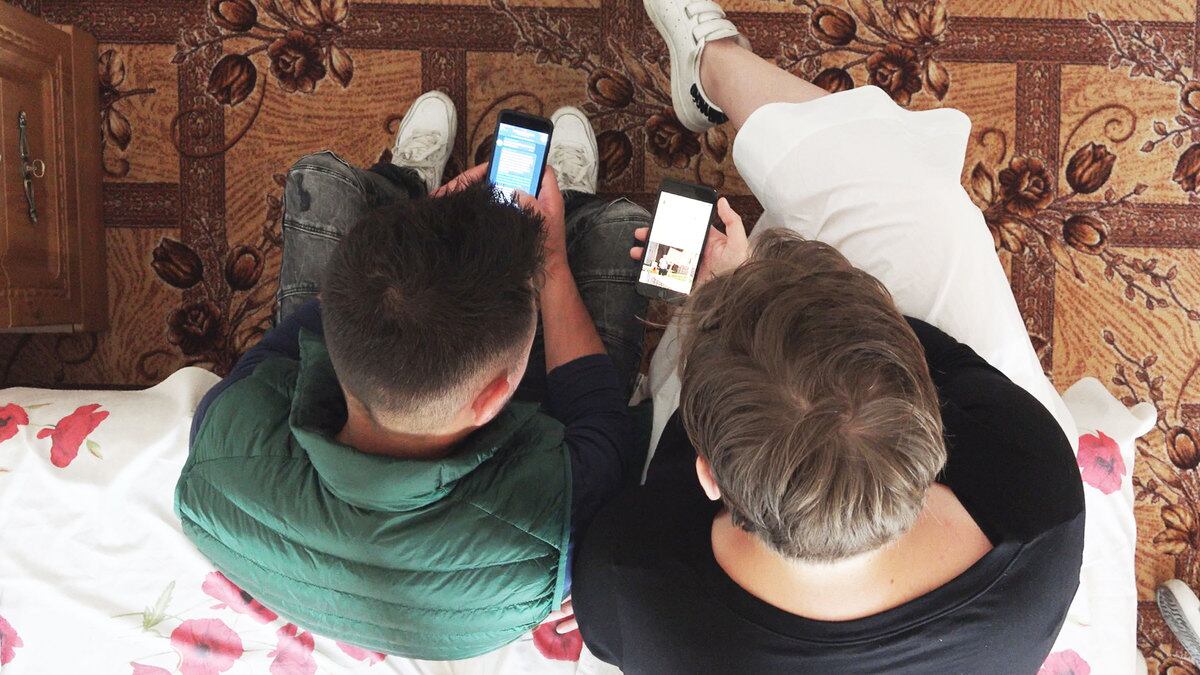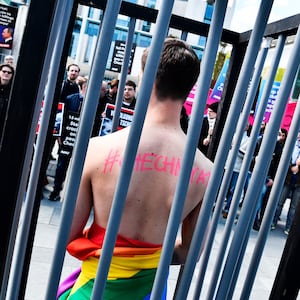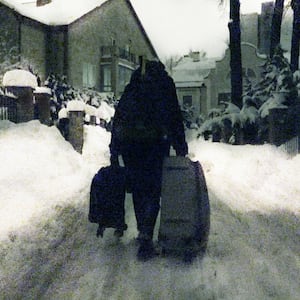In 2017, reports started circulating about the murders. There was torture, too. Violent extortion. Threats. People were “disappeared.” It was a gay purge. And it still is.
In the Russian republic of Chechnya, the gay community has been hunted. Read that word, and digest what it means. They have been hunted—and killed—for years.
Ramzan Kadyrov, the petulant MMA fighter turned Chechen leader, has vowed to “cleanse the blood” of his republic, forcibly eradicating the LGBT+ population. It is a humanitarian crisis that, despite the siren sounding three years ago in a flurry of investigative news pieces, has been essentially ignored by the Western world, even as the body count continues to climb.
“2017 was also the year that we were unfortunate enough to inaugurate Donald Trump,” says David France, the reporter and filmmaker behind Welcome to Chechnya, the searing new documentary detailing the effort to rescue Chechens from the gay purge, premiering Tuesday night on HBO.
“Trump has successfully flattened the news cycle,” France says. “Just as he was doing that, just as the media was suddenly hostage to every Trump tweet, that’s when the story first broke. The news media has a lot of responsibility for not having pursued the story, for not having kept it in the news cycle, and allowing the shenanigans in Washington to take all of the attention from this.”
Welcome to Chechnya first screened in January at the Sundance Film Festival, where impassioned whispers of “everyone needs to see this” passed up and down the streets of Park City.
France previously directed the Oscar-nominated How to Survive a Plague, about the transgressive efforts of activists fighting for their community’s lives during the AIDS epidemic, and The Death and Life of Marsha P. Johnson, the shattering spotlight on the life of the trans rebel whose name and legacy, all these years later, is finally being bellowed through megaphones in the Trans Lives Matter movement.
To make Welcome to Chechnya, France embedded himself among the organizers of a modern-day underground railroad that worked to secretly transport persecuted LGBT+ Chechens out of the country. The dangers and complications of that journey have not been seen in Eurasia since the French resistance against the Nazis.
The film is revolutionary, owing to the intimacy—and with it, the high stakes—France was able to capture with the men and women on their long, life-risking journey out of Chechnya. As such, Welcome to Chechnya is groundbreaking in ways not typically talked about in the world of documentary film.
In order to assure the safety of the film’s subjects, whose identities had to be protected because, even if they reached safety, they would still be hunted by the Chechen government, Welcome to Chechnya pioneered a digital technology that masked its participants’ faces.
The same artificial intelligence used to create “deep fakes”—synthetic media in which a person’s face is replaced with someone else’s likeness, made to seem as if they are speaking and living as the other person—is employed to protect the men and women fleeing persecution in the film.
Rather than having to obscure the faces of the documentary’s subjects or disguise their voices, France is able to illuminate a yet-unseen humanity to the harrowing situation in Chechnya.
Every other technique the filmmakers tried had the effect of making the subjects feel “less than human,” France says. “My goal in working with them was to help restore their humanity and help them regain control of their own narratives.”
Additional, and crucial, tools in that endeavor are the graphic, upsettingly violent videos that appear throughout the film.
In one, gays who are caught kissing in a car are gruesomely attacked. In another, a gay woman is dragged into the middle of the street by her relatives. One leaves to retrieve a boulder from the side of the road. He bashes her head in with it. Another video shows a man anally raped by police as punishment.
The videos are horrific. More, they were filmed by the persecutors themselves, the attacking officers memorializing their work.
“These are trophy videos that they have kept, and have shared among one another,” France says. “A kind of gleeful declaration of their accomplishment in this crime against humanity. I wanted you to see the glee with which the perpetrators were celebrating their work and I wanted to turn that on its head. I wanted to say, ‘What you created indeed is evidence. And this evidence makes it undeniable what’s happening there.’”
Ahead of its premiere—and in the thick of Pride Month, no less—we spoke to France about his experience in Chechnya chronicling the life-or-death escape missions of his subjects, who are hunted by their government because of who they love and how they identify. We get into the revolutionary technology he used to tell their stories, and why the Western world, specifically our own country, has chosen to ignore them.
With everything happening in the world, what is the situation like now in Chechnya?
I can tell you that the pandemic has made it almost impossible for anybody to help folks who need help in Chechnya. The Kadyrov regime shut down the border around Chechnya, one of the harshest shutdowns anywhere in the world, making it impossible for people even to leave their homes for a period of time. The border is still severely controlled. And so unfortunately things have gotten really much more dire for the people who are trying to make their way to some sort of a safe haven place.
Even with all the precautions for the pandemic, is there still the same level of violence and persecution?
The purges never really stopped in Chechnya. It has from time to time run out of leads. When they get new leads, it resumes in the same kind of tip-of-the-iceberg way that it began, which is that they bring in suspected queers, torture them for confessions and leads, and through the revealing of people that they know, bring those people in, too. That pattern has happened from time to time cyclically since 2017.
To go back to the beginning of this, how did you land on the approach where instead of just storytelling about the violence and the situation, you decided to embed in the effort to help people seeking asylum?
Well at least in 2017, the news media had some coverage of the atrocities being carried out there. So there was a base of knowledge about the crime. I wanted to tell the story from the perspective of the activists who are on the ground, working to try and stop this and save people in the absence of any sort of effective international outcry. To do that I needed to get to know them and watch them work.
What did it take to gain the trust of the people you were filming? Clearly their lives were on the line, so why would they agree to be filmed?
Some of the activists agreed right away, understanding that it would help raise the visibility of their organization and their struggle, which is a very expensive one, so that they can continue doing that work. Others were suspicious of me and my American gaze when I first arrived. I needed to convince them that I shared their commitment to getting the story out in the right way. And in a way that increased their security, rather than decreased it. The film brings international attention to their work in a way that offers them some measure of protection.
The facial disguising is crucial in protecting their identities. At what point in production did you figure out you can use that as a tool?
I had shot most of the film before we began our work on trying to find ways to disguise the people whose faces couldn’t be shown and could never be shown. It’s not that they couldn’t be shown at the point of filming. They will never be able to tell their stories publicly with their face and with their voice because they are literally being hunted. I made a promise to everybody that I would find some way to disguise them. I asked them to trust me. So it was after most of the principal photography for the film that we began the research and development that ultimately took us through every approach that documentary films have used in the past to protect identities. And none of them was satisfactory.
Why do you think those tried-and-true methods to disguise identities didn’t work?
They diminish the humanity of the people who are in a film by blurring their faces or making their voices mechanical sounding. We went to animators and had animators reinterpret them in the frame, and that again made them less than human. My goal in working with them was to help restore their humanity in a way and help them regain control of their own narratives. Ultimately, we threw our hands up thinking we weren’t going to be able to do this. Then a VFX company in L.A. proposed that maybe it would be possible to use AI technology that is used on deep fakes in a way that would allow us to actually transplant somebody else’s face digitally over the faces and heads of the people whose stories we’re telling.
Why was it important to you to include those horrific videos of people being beaten and tortured?
In the background to everybody’s story that unfolds in the film is their own experience with torture, their own experience with being brought close to death. It’s one thing to hear them talk about it, and it’s another thing to see what they see in their minds, which is captured in those videos. It’s the shadow that follows them through the film and will follow them for the rest of their lives. You can’t really understand their story without seeing that, without seeing the kind of cruelty and inhumanity that is being carried out in Chechnya, and elsewhere.
The important point, too, is that these are videos that were taken by the perpetrators themselves.
These are trophy videos that they have kept and have shared among one another in a kind of gleeful declaration of their accomplishment in this crime against humanity. I wanted you to see the glee with which the perpetrators were celebrating their work and I wanted to turn that on its head. I wanted to say, “What you created indeed is evidence. And this evidence makes it undeniable what’s happening there.”
The film specifies that of all the people whom activists have helped resettle in other countries, the Trump administration has taken a single one seeking asylum. But beyond that, outside of the initial flurry of press in 2017, people here have stopped talking about it. Why is that?
2017 was also the year that we were unfortunate enough to inaugurate Donald Trump, and he has successfully flattened the news cycle. Just as he was doing that, just as the media was suddenly hostage to every Trump tweet, that’s when the story first broke. The news media has a lot of responsibility for not having pursued the story, for not having kept it in the news cycle, and allowing the shenanigans in Washington to take all of the attention of this. When the pandemic hit, I think the news media was beginning a reckoning with the way it was constricting its coverage from around the world. So we’ll see whether or not we can bring this issue back to a political discussion. I think it’s going to be up to the media to do that.








